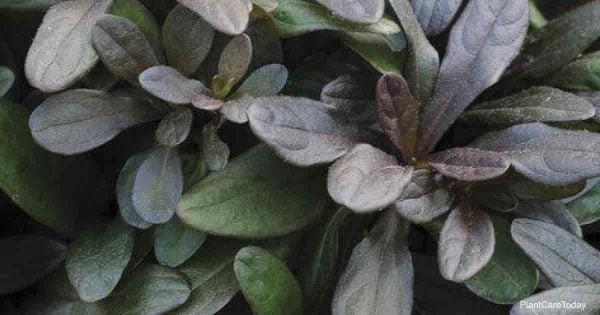The Ajuga reptans Chocolate Chip (a-JOO-guh, REP-tanz) is a member of the Lamiaceae family hailing from Europe.
The origin of the genus name of the plant is unclear, but the specific epithet, reptanz, means “creeping” and describes the plants’ spreading, rambling growth habit.

This herbaceous perennial is widely naturalized throughout the United States and may be commonly referred to as:
- Creeping Bugleweed
- St. Lawrence Plant
- Common Bugle
- Carpet Weed
- Bugleweed
- Carpet Bugle
- Bugle Herb
- Blue Bugle
- Ajuga
One cultivar of this plant was developed by the Italian Valfredda nursery and is called ‘Valfredda.’
This cultivar is commonly sold as “Ajuga Chocolate Chip.”
Although it is a bit fancier than what you might see naturalized in the wild, the care of all members of this hardy plant family is the same and is simple and straightforward.
Ajuga Chocolate Chip Care
Size & Growth
Ajuga Chocolate Chip has a very compact, dwarf growth habit.
Individual plants typically grow to be no more than 3″ or 4″ inches high with a spread of less than a foot tall.
The chocolate-colored leaves of these plants’ foliage are a deep shade of brown with burgundy highlights.
Plants form a dense mat of small, shiny leaves acting as an effective groundcover or look lovely spilling over the sides of containers.
The foliage grows densely enough to smother weed growth.
Leaves are somewhat delicate, though, and cannot tolerate foot traffic.
Chocolate Chip Ajuga Flowering & Fragrance
Chocolate Chip Ajuga produces very small, fragrant violet-blue flowers from the middle of springtime into early summer.

The showy whorls of blossoms grow on spikes, which rise above the foliage.
Blooms are very attractive to bees.
Light & Temperature
Ajuga plants are winter hardy in USDA hardiness zones 4 through 9.
All members of this family do well in lighting conditions ranging from partial shade to full sun.
A partial sun setting providing between four and six hours of sunlight daily is best for the best foliage colors.
Watering & Feeding
During the hot spring and summer months, you may need to water Bugleweed deeply about once a week.
Keep in mind this is an easily naturalized plant that does best when treated as a wildflower.
Depending on your climate, you may need to water deeply about once a month in fall and winter.

Generally speaking, Bugle Herb does not need to be fertilized unless the soil is extremely poor.
Use a weak solution of liquid fertilizer.
It’s best to fertilize in the morning and water deeply immediately after fertilizing.
Soil & Transplanting
Carpet Bugle is well planted in well-draining, humusy soil with medium moisture.
When establishing plants, allow about a foot of space between each plant unless you want ground cover very quickly.
In this case, place plants 6″ – 9″ inches apart.
Chocolate Chip Ajuga Plant Grooming & Maintenance
Plants will appreciate having more space between them and better air circulation if you live in a humid area.
When flowers have finished blooming, cut this ground cover all the way back to the ground.
This will help to rejuvenate the foliage.

If you’re using Ajuga as a lawn replacement, mow it with your mower on the high setting.
This will remove spent flower spikes and impose a tidy, uniform appearance.
If yours is a variegated form of Ajuga, be on the lookout for non-variegated leaves.
Remove them promptly if and when they appear.
How To Propagate Ajuga Reptans
This creeping plant self-propagates easily by sending out stolons or propagating manually through division.
In the fall, thin the plants about a month before the first predicted frost.

Do this by digging up a clump and then dividing it by pulling the roots apart or splitting the clump with your shovel.
Amend the soil as needed and replant one-half. Relocate the other to its new setting.
Ajuga Reptans Pest or Disease Problems
Ajuga plants are subject to crown rot if overcrowded or conditions are too humid.
Additionally, very heavy soil will cause crown rot. Otherwise, it is fairly impervious to pests and diseases.
It tolerates deer and rabbits and is well-planted under and around Black Walnut trees.
The plant is also quite drought-tolerant.
Is The Ajuga Plant Toxic Or Poisonous?
All parts of all members of this plant family are toxic if ingested.
Is This Plant Invasive?
This enthusiastically growing, easily naturalized plant is listed as invasive.
While the Chocolate Chip cultivar is not specifically listed as invasive, it’s important to understand it has tremendous potential to become so.

If you plant it in a conducive climate, take care to keep it contained within your garden.
A setting strongly bordered by sidewalks, driveways, patios, and other types of hardscape will prevent plants from spreading with wild abandon.
Suggested Ajuga Chocolate Chip Uses
The chocolate chip ajuga plant’s rapidly growing groundcover is an excellent lawn replacement and provides some erosion control on slopes and banks.
Because of its dwarf size, it’s a good choice for planters in small spaces.
Its growth habit makes it a nice candidate for hanging baskets, rock gardens, and containers.